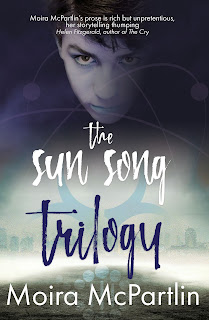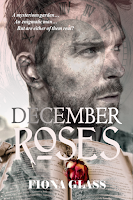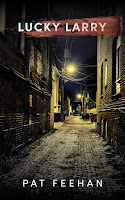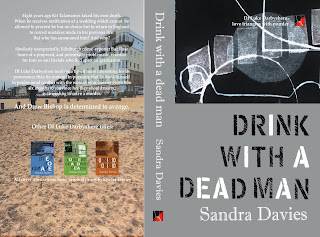I’m delighted to welcome to my blog this week author Linda Cracknell, a prize-winning writer of intense and beguiling prose. I’ve long been an admirer of Linda’s work and was eager to read her latest book.
 |
| The Other Side of Stone pictured with Glen Lyon Tweed |
The Other Side of Stone, published by Taproot Press, is a collection of linked stories centring on an old stone-built weaving mill in rural Perthshire. Over the course of two centuries, the stories follow the creation and eventual decay of the building and the industry, and the impact this has on the people connected with it. Each story is self-contained, but together they build into a rich and coherent whole – layered like storeys in the building itself. This is an awesome achievement and a thoroughly satisfying experience for the reader.
In the opening
story, Stone Curse, an old journeyman stone-mason inscribes the foundation
stone for the radical new water-powered mill. His focus is on his work and the
immediate surroundings of his workshop. It’s about the hard rock and the
‘fleabite’ of an indentation each strike of his chisel makes on it, putting
into context our puny human concerns. The language is distilled and
concentrated, deep with meaning. Indeed, even the word ‘strike’ becomes a
recurrent motif in the collection. On the main face of the stone, he is carving
the date – 1831. On the reverse, to be hidden away, he chips out an effigy of a
woman. While the reader is drawn to the stone-mason – perhaps because of the
affectionate way he describes a tiny visiting bird – this image he’s struck
into the hard stone is his way of imprisoning the rule-breaking woman, and I
would say this social mistrust of non-compliant womanhood and this need to
restrict and restrain is central to The Other Side of Stone.
Look at Linda’s descriptive powers, right from the opening paragraph, describing that wee bird!
Some days it’s just the wee fellow who watches me. I see him through the hazel-arch of the workshop when I turn my head, and he’s there when I take my tools out to the forge to be licked sharp in the flames. He perches on the top of the rubble pile, or on a post, and observes. A smart-looker he is, with his white collar and chestnut stomach. Out of his dark face comes a scolding cry when there’s someone coming. He’s an unquiet bird then, with his ‘clack-clack-clack’, for all as if he’s bashing two stones together. … And the fellow’s my friend is he not? He’s my steady companion, watching me force the chisel upon the rock that’s so brute-hard my scours and drafts will be there to see for centuries to come.’
Linda takes us ranging back and forward over the years from 1831 to 2019, tuning in to the deepest concerns of workers and mill owners and others connected to the building throughout the phases of its origin, heyday and decline. What impresses me so much about Linda’s work – over and above the immense skills with language and observation – is that she rapidly establishes the feel of each era, with all its political considerations and pressures.
One storyline is returned to several times, weaving its way through the others. Set in 1913, it follows a young married woman who’s committed to achieving workers’ rights and women’s suffrage. She remembers May Day celebrations in Glasgow when her husband was a Union man and they were full of optimism, believing in unity and solidarity among the workers – until he accepted a promoted post in Perthshire. All like one big family, so we were … and Miss Sylvia Pankhurst herself up there, saying that the cooperative commonwealth will only happen if women as well as men manage it. (p.58) Catharine describes how alien she feels in this rural village, especially now he’s turned his back on their beliefs, in the words I’m like a flower grown from a seed that’s blown in from foreign parts’ (p.60) She has vision and ambition, and yearns to train as a nurse, but this is all in question. Will her husband sign the letter giving his permission?
 |
| Author Linda Cracknell (Photo by Robin Dance) |
Q&A
CMcK: Hello Linda, and welcome to my book blog! I have long been an admirer of your writing. Loved your short stories, of course, and your novel Call of the Undertow. Your creative non-fiction collection Doubling Back: Ten paths trodden in memory is another of my favourites. Before we get on to talk about The Other Side of Stone, let me ask – do you have a favourite form? How do you decide what form to write? What’s your process?
LC: Hi Carol, and many thanks for having me along. My process seems to be quite chaotic and hard to predict! The Other Side of Stone is my fifth book but there was no direct route or clarity as it developed. I usually start with character and place, and perhaps a ‘what if?’ train of thought or a particularly illuminated moment (which is likely to end up as a short story). I started writing short stories in the late 1980s after which I had two collections published. I love the economy and the elliptical nature of that form, but agree with Richard Ford when he calls it the 'high wire act of literature', because one tiny slip and the whole thing fails. The novel form is more forgiving.
As a new writer, there was quite a bit of pressure to produce a novel in order to be taken seriously, and it was setting out to write a novel in 2001 and then a few years later abandoning it that provided the foundation stones for this most recently published book. Although that first novel didn't ever quite work, when my explorations of an area around Dunnet Bay in Caithness offered up a story arising from an underlying folktale, it definitely had to be novel-length and Call of the Undertow (2013) was the result. Since then I've written another novel, currently looking for a publisher, set between the Scottish Highlands and the limestone sierras of south-eastern Spain in a story of mountains and suppressed memory. And I also write essays. Doubling Back: Ten paths trodden in memory (2014), was a linked collection of these, exploring place and memory through repeated footfall on paths. That also took its time to arrive at a final form.
In answer to your question I think the form probably asserts itself gradually as I write. Somehow, 20 years after setting out to write my first novel, I've ended up with this hybrid work of fiction which may be a novella or may be linked short stories, but definitely isn't a novel!
 |
| https://www.lindacracknell.com/mybooks-buyhere.asp |
CMcK: So, The Other Side of Stone – it’s breathtakingly beautiful prose, deeply evocative of place and the tangible, physical world. Tell me how it came about, and something about your themes.
LC: The original novel I started writing in 2001 included two storylines which survived into 'Stone' but are now given very different weights. The major story is now a minor one and vice versa. In the act of abandoning the project I seem to have found the liberty to do as I pleased without the crippling self-consciousness which can come with anticipating publication. I returned over the years to the research and imaginative work I had done on the setting of the Perthshire woollen Mill. What was particularly compelling to me in what remained was the story of Catharine in 1913-14, a frustrated suffragette who arrives with her new husband, a weaver, in the small Perthshire village and finds herself increasingly isolated by her radicalism. The original novel also focused on the early years of this century when the building was being converted into flats by an ambitious young architect, and was somehow being dogged by the past. Around these two strands I gradually picked up other periods of the building’s history which interested me and wrote occasional new stories which used that background. I never imagined it would be published as one coherent work until last year I pasted them all into one document and added a final, more recent story which helped it all add up. It was a gamble that I could trust the reader to bridge the gaps not just within the stories themselves but between them. It seems to have paid off.
The strongest themes in my writing are usually place and memory, and that's certainly the case here with layers of history even within the stone itself. I like to think that the mill becomes a character itself through the different faces it shows in different periods. Beyond this, the overriding theme of the book has turned out to be the agency of women, and the struggle for this freedom as well as the potency of the local landscape and the effect of industrialisation on rural areas. I never set out to write to themes but let them emerge out of preoccupations with the setting and characters I've chosen.
 |
| https://taprootpressuk.co.uk/our-books/ Photo courtesy Robin Dance |
LC: I'd say probably the latter, that the language must be an aspect of character. Catharine basically speaks monologues to the building itself, so it had to suggest the syntax of a Paisley cotton mill lass. Although it's not my own language, I did enjoy evoking it. And in 2019 Jade’s manner of speech, as a young carer who has failed in her formal education, needed to reflect her great weariness as well as background and the age in which she lives. It had to at least suggest authentic teenager.
CMcK: As well as being a versatile and accomplished published author, you’re an inspirational creative writing tutor. Where can we learn more about you and your writing, and buy copies of your books?
LC: I love
teaching and encouraging others to write. The maxim I work by is Susan Sontag's:
'Love words, agonise over sentences, and pay attention to the world.' It works.
I also like to get people outside and moving as part of the writing process.
Over the period of the pandemic it has been quite difficult to continue with workshops,
some of which are residential, but hopefully such things will gradually come
back. I have found that as long as they're not too long, workshops on Zoom over
a period of time can work very well and can defeat geography. I'm currently
writer in residence for the Birnam Book Festival and will soon be running a
course with them.
I have a regular newsletter in which such workshops as well as writing tips, various extras, and news of my own books can be found. Anyone can sign up through my website at this link: https://www.lindacracknell.com/feedback.asp
The Other Side of Stone (after a surprise sell-out of the hardback!) is now available as a paperback for £9.99 and can be ordered either directly from the Taproot Press website with no postage to pay https://taprootpressuk.co.uk/our-books/ , or ask your local independent bookshop to order it in for you. Call of the Undertow is available from my website as a special edition hardback and each of my other books is in print. As they've been with different publishers one of whom went into liquidation, they are available in slightly different ways. You can learn how here: https://www.lindacracknell.com/mybooks-buyhere.asp
For anyone who’d like to hear more about The Other Side of Stone, here’s Birnam Book Festival’s event in which I discuss it with Jane Archer. https://www.facebook.com/watch/?v=190050849708686
Thank you,
Carol, for inviting me to participate in your wonderful blog. And thanks to
your readers who have got this far!
CMcK: My pleasure, Linda!
 |
| Author Linda Cracknell (Photo by Robin Dance) |































